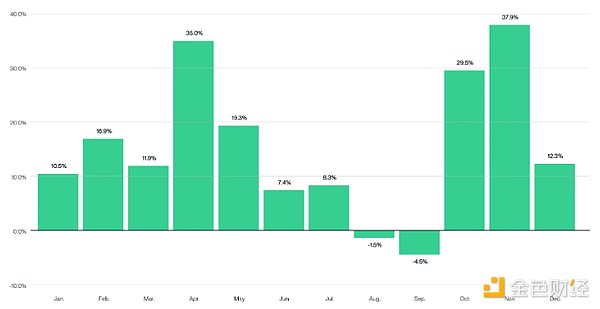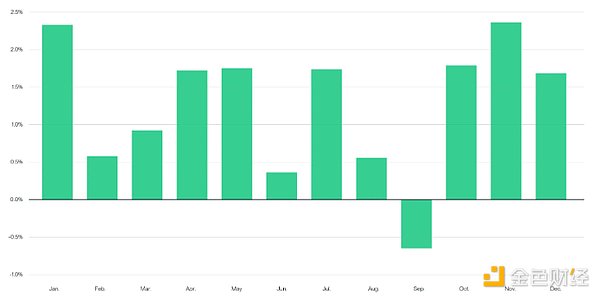Author: Matt Hougan, Chief Investment Officer of Bitwise; Translated by: 0xjs@ Jinse Finance
September was terrible.
Since Bitcoin began trading in 2010, the asset has lost an average of 4.5% in September. This is the worst performing month ever and one of only two months with a negative average return .
Average monthly returns of Bitcoin from 2010 to 2024

Source: Bitwise Asset Management, data from Glassnode and ETC Group. Data range is from August 2010 to September 2024.
On closer inspection, things aren’t getting any better. Bitcoin has fallen in nine of the 13 Septembers on record, according to a detailed analysis by NYDIG. September 2011 was Bitcoin’s worst month ever, with a 41.2% drop. As of last Sunday, Bitcoin was down 7% so far this month.
As the Green Day song goes, “Wake me up when September ends.”
What is driving the “September effect”?
There is a lot of discussion about what causes the September Effect. While no single theory is particularly convincing, I have found three main theories:
1. September is a bad month for all risk assets
Bitcoin isn’t the only asset to be impacted by the back-to-school season . Since 1929, September is the only month in which the stock market has seen more declines than gains. The effect is particularly pronounced in the tech-heavy Nasdaq 100.
Economists have tried to attribute this to a variety of factors — increased volatility after a summer economic slowdown, losses suffered by mutual funds at the end of the fiscal year — but no one is sure.
Whatever the reason, it's happening again: As of Friday, September 6, the Nasdaq 100 is down nearly 6% this month.
Average monthly gain of the Nasdaq 100 Index

Source: ChartoftheDay.com. Data range is from January 1985 to December 2023.
2. SEC enforcement season puts pressure on cryptocurrencies
The SEC’s office hours run from October to September each year. Historically, this means you tend to see a lot of enforcement actions in September as lawyers try to fulfill their quotas for the entire year. Unsurprisingly, the SEC enforcement season is heating up: this month, we’ve already seen a meaningful settlement with crypto fund provider Galois Capital , as well as a Wells Notice against NFT platform OpenSea . Many predict that by the end of the month, litigation and settlements against crypto entities will be even more intense . I wouldn’t be surprised; I’ve been hearing rumors of larger enforcement actions since early summer, and we’ve long warned about the dangers of the SEC enforcement season.
I'm not sure the SEC's sword of Damoclitus is enough to explain the "September effect," but it's certainly not bullish.
3. Reflexivity
Probably the best explanation I've heard for the September Effect is that it's simply self-reinforcing: People now expect September to be bad, and it is. While that may not sound earth-shattering, it's not: expectations drive markets.
In contrast, Bitcoin investors have historically loved October — after all, October is known as “Uptober,” thanks to Bitcoin’s average 30% gain that month. This may have fueled investors’ animal spirits. Historically, October and November are among the best months for cryptocurrency investors .
Outlook
Like many, I'm not quite sure what to make of the "September Effect." It's unclear how much of an impact the above factors have, whether it's purely an anomaly, or whether there are a variety of untapped forces at work. Regardless, it's affecting the psychology of today's markets.
What I do know is that, aside from seasonal factors, it’s most important to focus on the specifics of the current market. When I do that, I begin to understand the reasons behind the weakness in cryptocurrencies this September.
Markets hate uncertainty, and there is a lot of it right now. Consider this:
The U.S. presidential election will have a major impact on cryptocurrencies, and it is currently a close call, with varying odds depending on whether you follow Polymarket, PredictIt, or 538. I think we will see markets struggle to find their footing until we have more clarity on future leadership and policy.
The timing and magnitude of the Federal Reserve's rate cuts have sparked a fierce debate. Despite widespread consensus that loose monetary policy is coming, investors are feverishly recalibrating their bets: the probability of a 50 basis point cut in September has fallen, but the probability of a cut of more than 125 basis points in December has risen.
ETF flows are mixed . While inflows into Bitcoin and Ethereum ETFs have slowed (the U.S. Bitcoin ETF just experienced its longest period of net outflows since its launch in January), if you look closely, investment advisors are adopting Bitcoin ETFs faster than any new ETF in history .
My base case is that as this uncertainty starts to dissipate in October and November, we'll see a big rebound . This is consistent with historical trends, which may or may not be a coincidence. Either way, I'm prepared.







